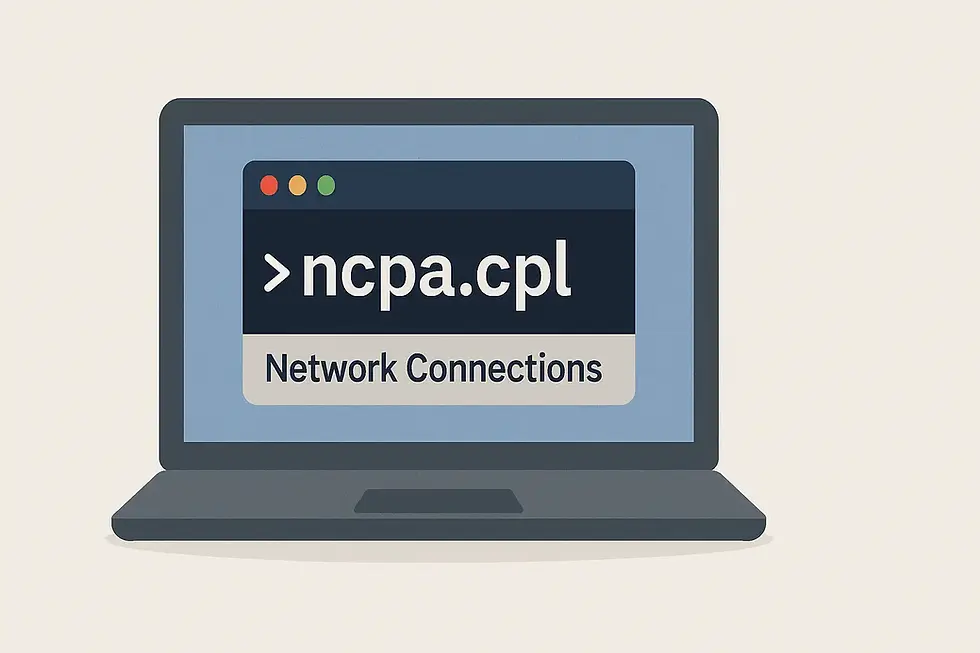What Is sysdm.cpl? Use It to Tweak System Properties Like a Pro
- Kalyan Bhattacharjee

- Jul 11
- 3 min read
Updated: Nov 22

Introduction | sysdm.cpl
Ever wanted to rename your PC, tweak virtual memory settings, or manage System Restore like a tech expert? There's a hidden gem inside Windows that lets you do all that - it's called sysdm.cpl.
This powerful control panel shortcut is the backdoor to advanced system settings in Windows. Whether you're optimizing performance, customizing startup settings, or just curious, this guide will show you how to use sysdm.cpl like a pro.
What Is sysdm.cpl? 📌
sysdm.cpl is a Control Panel command file that opens the System Properties window directly. It’s been part of Windows since the XP era and still works in Windows 10 and 11.
Running it gives you quick access to deep-level system configurations, many of which aren’t available through the new Settings app.
How to Open sysdm.cpl 🛠️
Opening sysdm.cpl gives you quick access to advanced system settings in Windows. Here’s the simplest way to launch it in just a few seconds.
Method 1: Run Command ✅
Press Win + R
Type sysdm.cpl and hit Enter

Method 2: Via Command Prompt or PowerShell ✅
sysdm.cpl

⚡ Pro Tip: Pin it to your taskbar for fast access!
What Can You Do With sysdm.cpl? 🔍
The sysdm.cpl panel lets you manage essential system functions like performance settings, environment variables, device protection, and user profiles. Here's what each one unlocks:
Computer Name Tab 🔧
Change your PC name
Join or leave a domain or workgroup
Useful for network identification and personalization
✅ Great for: Office setups, remote access naming, syncing across devices
Hardware Tab 💻
Access Device Manager quickly
Manage Driver Installation Settings
Set whether Windows should download drivers automatically
✅ Great for: Troubleshooting drivers, hardware updates
Advanced Tab 🧠
This is where power users live.
➤ Performance Settings
Adjust for best performance or appearance
Tweak visual effects like animations, shadows, and font smoothing
➤ Virtual Memory
Manage paging file (swap space)
Improve performance on low-RAM systems
➤ Processor Scheduling
Prioritize background services or programs
Optimize for gaming or server usage
✅ Great for: Speeding up old PCs, heavy multitasking, game optimization
System Protection Tab 🗓️
Enable or disable System Restore
Create restore points manually
Manage disk space usage for restore points
✅ Great for: Safeguarding your system before risky changes or updates
Remote Tab 🔄
Enable or disable Remote Desktop
Set remote assistance permissions
✅ Great for: Remote work, tech support, accessing PC from another location
Real-World Use Cases ⚙️
Goal | sysdm.cpl Feature |
Rename your PC | Computer Name tab |
Optimize performance | Advanced > Performance Settings |
Extend virtual memory | Advanced > Virtual Memory |
Enable System Restore | System Protection tab |
Set up Remote Desktop | Remote tab |
Bonus: Keyboard Shortcut Combo 🧠
If you frequently use sysdm.cpl, consider creating a desktop shortcut:
Right-click on desktop → New → Shortcut
Enter: sysdm.cpl
Name it “System Properties”
Done!
Is It Safe to Use sysdm.cpl? 🔐
Yes - it's 100% safe and built into Windows. But be careful when adjusting memory or system protection settings, especially on production machines. Always create a restore point first.

Conclusion ✅
The next time you want to optimize your Windows experience, whether it’s for speed, stability, or customization - don’t dive into complex tools. Just run sysdm.cpl and start tweaking like a pro.
This small yet mighty command gives you total control over system behavior, making it a must-know for power users and beginners alike.
Related Keywords: sysdm.cpl, sysdm cpl, what does sysdm cpl do, sysdm cpl editenvironmentvariables, control sysdm cpl, what is sysdm cpl, what is sysdm.cpl, how do i access sysdm.cpl on windows 10, control panel from command prompt, cmd launch control panel, open control panel from cmd, control panel run command, command prompt control panel, sysdm.cpl windows 11, open system properties windows shortcut, change PC name using sysdm.cpl, advanced system settings Windows, virtual memory settings windows 10, fintech shield







Comments